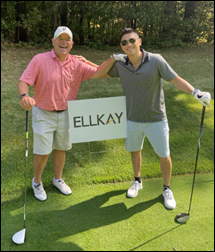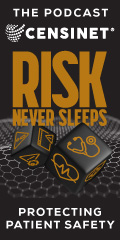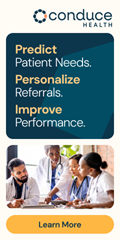Frank McGillin, MBA is CEO of The Clinic by Cleveland Clinic.

Tell me about yourself and the company.
I’ve been in the CEO role of The Clinic by Cleveland Clinic for the last five years. We’re a joint venture between Cleveland Clinic and Amwell. Our mission is all about expanding access to Cleveland Clinic’s expertise by leveraging digital technology. My background is a combination of digital health as well as consumer healthcare.
How does the organization work with Amwell?
Cleveland Clinic is the majority shareholder of the joint venture and Amwell is a minority shareholder.
We have a close relationship with Amwell. We run our solution on Amwell’s Converge platform. We also do co-marketing and work through their sales channel. The partnership with Amwell has helped ensure that we have the tools and technology to make it easy for patients to access the expertise, as well as making it easy for the clinician to deliver the second opinion.
What motivates patients to seek a second opinion and what kinds of patients do so most often?
Typically an individual will seek a second opinion when they are faced with a consequential decision. They’ve gotten a cancer diagnosis, been told that they need surgery, or have a condition that isn’t getting better. They want to understand their options.
Second opinions have been going on for as long as medicine has been around, but the ease of getting a second opinion depended on who you know or where you are located. With the virtual second opinion program, we try to eliminate those speed bumps. Regardless of where you are based — whether it’s a rural county in the United States or whether you’re deployed with the State Department overseas — we can help you access that expert, whether it’s an oncologist, a cardiologist, a neurologist, or any other subspecialist to help you understand your treatment options, review the accuracy of the diagnosis, and present some of options for managing your condition moving forward.
Two-thirds of your second opinions result in a different diagnosis or recommend a change in the treatment plan, and patients usually accept those recommendations. Does that indicate that the original doctor made a mistake or that they did not have access to the right resources?
Various factors could drive a change in the diagnosis and the care pathway. With diagnosis, a typical or potential area would be a rare condition that local physicians don’t see regularly, so you can bring in a specialist who is dealing with those cases on a more regular basis. They are able to identify and diagnose more accurately. Sometimes it’s a matter of reinterpreting pathology and having subspecialist pathologists looking at the specimens and getting more specific in terms of the nature of the cancer type to ensure that we are targeting the right disease state with the right solutions.
In other cases, it could be a treatment option that is beyond the scope of a local care provider. We had a patient from the Pacific Northwest about a year ago who was told that she needed a heart transplant because of the advanced nature of her heart disease. In the second opinion, the Cleveland Clinic cardiologist identified this patient as being a candidate for stenting. The Cleveland Clinic cardiologists deal with the most complex cases in the world. They have experience stenting people with more advanced heart disease than potentially a regional hospital.
Finally, it’s about advances in care, whether it’s new approaches for radiation therapy or clinical trials that may be available for a cancer diagnosis.
Are patients surprised when their second opinion differs from the first one? How do they determine which one to trust?
Someone who is seeking a second opinion is looking for one of two things. One is the confidence and comfort that they are moving in the right direction, particularly if we’re talking surgical or other significant medical procedures. They want to have the confidence that they are going in the right direction. They want to have the confidence that it’s the right diagnosis.
Consumers are becoming more active in managing their healthcare with high-deductible plans. They are bearing more of the cost and are becoming more educated in leveraging health data online. But at the end of the day, they realize that if they are dealing with a significant health issue, they want to access the best expertise.
With a virtual second opinion program, we eliminate the need to travel. We eliminate the need to do the research to figure out who is the best specialist match for you. We make it easy for you to get that peace of mind.
How do you collect and assemble the patient’s medical records and present them to the second-opinion physician for review?
Unfortunately, we’re not in a world where it’s universally easy to access medical records. Part of the benefit that we offer to the individual is that our team goes out and hunts down your medical records, your imaging, and your pathology, because without high-quality records, the specialist isn’t able to render a quality second opinion. In some cases, there is electronic data transfer from the EHR and we can get your records basically instantaneously. In other cases, we’re still getting faxes. We leverage technology where it’s available, but other times, we need to do the legwork to get it done.
On the back end, we’ve tried to make it easy for the clinicians to work it into their workflow. We’ve integrated our second opinion process into the EHR. When a specialist agrees to take on a case, that makes it easy because they are working in a workflow that is native to them and that lets them be efficient with their valuable time.
Is the process limited to a review of the existing records or does the physician ever decide that they need additional tests or information from the patient?
We are generally able to get sufficient data. As a second opinion program, in 99% of the cases, adequate testing has been done prior to the second opinion being rendered. There are cases where we will have to request some additional scans that may or may not have been done, or some additional testing to make sure that the specialist has all the information that they need to render a quality opinion.
Doctors often say that you treat the patient, not the data. Does the second opinion process devalue the patient’s self-assessment or their treatment goals that might not be reflected in tables of data?
Part of our process is that we do an in-depth onboarding interview with every patient who comes in through the program. It’s done with one of the registered nurses on our staff. During that intake, we ensure that we have a robust profile of that patient. What has their journey been in managing their own health, not just their most recent doctor visit? We try to understand the areas where they have questions or concerns. We are able to pull together a comprehensive profile before the Cleveland Clinic physician steps in to help with the second opinion.
In the majority of the country, we are also able to offer a video visit as part of the second opinion process. That’s dependent on whether we have a licensed specialist in the state where the person resides. Cleveland Clinic physicians have broad licensing and are able to meet that need for the majority of people who come through the program. That gives both the confidence and comfort as you are dealing with the specialist. For the specialist, it adds an extra layer of being able to evaluate the patient during that interaction.
What does the patient do with the second opinion’s recommendations? Is the regular physician looped into the consultation results to decide whether to make treatment changes?
At the completion of every second opinion, we deliver electronically to the patient, and generally also to their local provider, a written report that outlines the findings, recommendations, and suggested next steps. That provides a foundation for deciding where to go. That could be seeking a different approach, a more aggressive treatment approach, or a more conservative approach. It really depends on that individual.
Sometimes the recommendation is for a procedure that may not be available locally. In those cases, patients often transfer care, sometimes to Cleveland Clinic, but at other times to perhaps a academic medical center that’s in their own geography.
Do local physicians and health systems see the second opinion service as competitive or as an unwelcome review of their decisions? Does the patient tell their own doctor ahead of the time that they are seeking a second opinion?
We believe firmly that healthcare is a team sport and that you get the best outcomes with multidisciplinary teams. If you have a local physician who is not open to input from their peers, we think that should set off a red flag. We try to be collaborative. We will facilitate conversations between the treating physician and the Cleveland Clinic specialist if there are questions.
We see this as supplementing and providing additional level of expertise as opposed to competing. Unfortunately, there are some misaligned incentives. There are times where there are some recommendations for overtreatment. We may ruffle a few feathers, but at the end of the day, the recommendation that the Cleveland Clinic physician is providing is always what is in the best interest for that patient.
Do the physicians who render second opinions volunteer for that work? Do they carry out a normal practice as well?
We have a large cohort of Cleveland Clinic specialists who participate in the program. They all have day jobs, so they are all working day-in, day-out, whether it’s cardiac surgery or medical oncology. They’re doing this in addition to their normal clinical responsibilities.
There are a couple of drivers behind this. One is that they realize that there are care deserts out there. More than half of the counties in the US don’t have a cardiologist. They realize that Cleveland Clinic quality care is not available everywhere.
The other thing is that these are generally complex cases. They are interesting cases for clinicians at an academic medical center like Cleveland Clinic. There’s the motivation to be helping these patients with the most complex conditions.
What happens once the patient has completed the intake and initial paperwork?
Our process end to end is generally 10 to 14 days. It can go quicker if we’re able to get medical records instantaneously. But generally, the long pole in the tent is the medical record. After the nurse intake, we gather all the medical records, the imaging, pathology, and any other testing data that’s available. Our team assembles that electronically for ease of review by the Cleveland Clinic specialists. A lot of the value that we add is in matching the patient with the right specialist, the right subspecialist.
The typical consumer who is coming in just knows that they want the best. Often we’ll have people say, “I want Dr. Jones or Dr. Smith. I see that they are head of the department.” That actually may not be the best match based on their specific conditions. We put a lot of energy into the matching.
Once we match the patient and the physician, the review is usually one to two days as they are reviewing and preparing for the second opinion. They are drafting a written second opinion report. The bulk of the time, they will have a video consult with the patient. Then the patient receives the written second opinion report.
Much of the perceived value is the Clinic’s brand name and its lack of financial misalignment. Could that philosophy change how medical services are delivered generally?
I don’t think you can paint all physicians with the same brush. Cleveland Clinic physicians are all staff physicians. They have zero financial incentive to recommend anything other than what is in the best interest of the patient. Not all medical institutions operate with that same model. So part of it is the DNA of the Cleveland Clinic physician. Another part of it is that the second opinion program is one step removed, which also helps improve objectivity.
Based on that, we have been able to show that on average for employers and health plans, we are saving them $8,700 per patient or per employee who goes through the program. Those savings generally come down to avoiding unnecessary procedures, unnecessary surgery.
It’s common for us to see a patient coming in who is scheduled for back surgery, but our review indicates that it isn’t necessary for the patient, and that less-invasive, more conservative approaches would be in that patient’s best interest. You can imagine not only the cost savings, but the personal impact of avoiding surgery and the ensuing recovery.
What does the ability to render second opinions remotely using existing patient records mean for the future of healthcare?
As medicine advances, it becomes more specialized, more subspecialized. The mismatch between demand and availability of specialists will only get worse. We believe that digital tools and digital programs can be that force multiplier that would expand the reach of an individual specialist so that they can treat even larger populations. The digital tools also eliminate that need for the patient to travel to that specialist, so we can cover broader geographies.
We see a future where digital tools and programs leverage the specialists, the local physician, APPs, and pharmacists through integrated programs to help dramatically improve the health and wellbeing of large populations of people who are living with chronic disease and get them access to the care that they normally wouldn’t be able to access on their own.
About 800,000 Americans are misdiagnosed each year. Large swaths of the country don’t have access to high quality specialists. We believe that programs like the Second Opinion program by Cleveland Clinic help fill an important gap that not only saves money, but also makes a fundamental impact on the quality of people’s lives.
Comments Off on HIStalk Interviews Frank McGillin, CEO, The Clinic by Cleveland Clinic


































































































































Hard agree with "actionless figure" - I realize that LinkedIn is the only mostly-non political form of social media we…